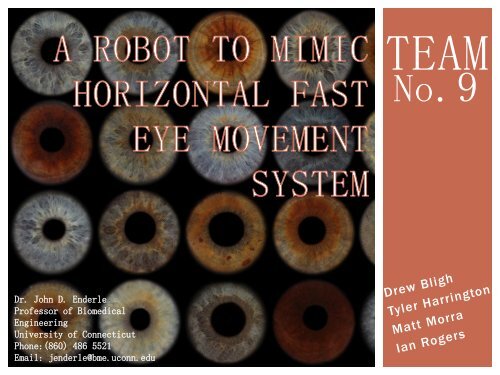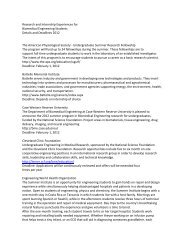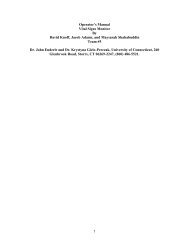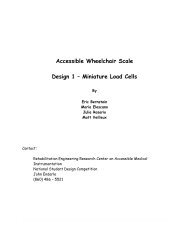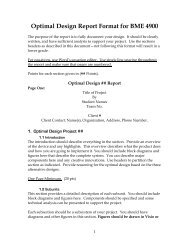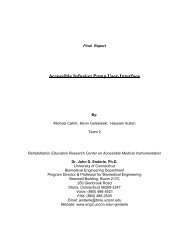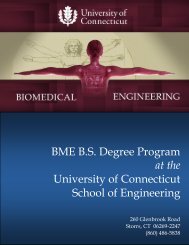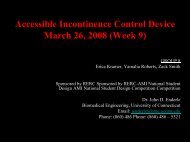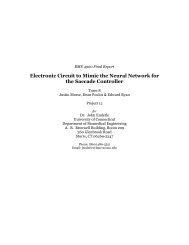A Robot to mimic horizontal Eye Movement - Biomedical ...
A Robot to mimic horizontal Eye Movement - Biomedical ...
A Robot to mimic horizontal Eye Movement - Biomedical ...
You also want an ePaper? Increase the reach of your titles
YUMPU automatically turns print PDFs into web optimized ePapers that Google loves.
Dr. John D. Enderle<br />
Professor of <strong>Biomedical</strong><br />
Engineering<br />
University of Connecticut<br />
Phone:(860) 486 5521<br />
Email: jenderle@bme.uconn.edu<br />
TEAM<br />
No.9
Main Goals<br />
• Replicate the Linearized Horizontal Fast <strong>Eye</strong> <strong>Movement</strong> System<br />
• Quickly target a stimulus in a +/-20°range<br />
• Camera inside the eye will capture an image<br />
• Image will be processed and appropriate movement executed<br />
• <strong>Movement</strong> should <strong>mimic</strong> that of the human Saccade<br />
• Target Saccade profiles for Human <strong>Eye</strong><br />
• Speed<br />
• Acceleration<br />
• Viscoelasticity<br />
• Precision
Ana<strong>to</strong>my<br />
• <strong>Eye</strong><br />
• Optical Nerve<br />
• Six Muscles<br />
Types of <strong>Movement</strong><br />
• Smooth Pursuit<br />
• Vestibular ocular<br />
• Op<strong>to</strong>kinetic<br />
• Vergence<br />
• Saccades
This linear muscle model exhibits accurate nonlinear force-velocity and length-tension<br />
relationships. No other linear muscle model <strong>to</strong> date is able <strong>to</strong> accurately reproduce<br />
these nonlinear relationships.<br />
• Each branch models a specific muscle<br />
• Medial Rectus muscle modeled by the<br />
Total Agonist force.<br />
• Lateral Rectus muscle modeled by the<br />
Total Antagonist force.<br />
<br />
Superior and Inferior Rectus’ muscles<br />
modeled by a single spring and dashpot<br />
in parallel.<br />
<br />
F ag<br />
and F ant<br />
represent the agonist and<br />
antagonist active-state tensions. These<br />
are our controls over the system.
• F constants represent<br />
forces based on the<br />
ocularmo<strong>to</strong>r elements.<br />
<br />
Tau and cap T constants<br />
intrinsic <strong>to</strong> humans and are<br />
set values based on<br />
experimental data.<br />
• Fag and Fant functions will<br />
output <strong>to</strong> the mo<strong>to</strong>rs.
• Neural and Agonist/Antagonist<br />
inputs shown <strong>to</strong> the right.<br />
• These inputs produce a 15<br />
degree simulated saccade with a<br />
max velocity of 400 deg/s.<br />
• The Agonist/Antagonist inputs<br />
are relayed <strong>to</strong> the mo<strong>to</strong>rs as<br />
force/time inputs for movement.<br />
• Simulink block diagram simulates the<br />
function of the eye robot.<br />
• Constants are defined in a MATLAB<br />
workspace.<br />
• Workspace is then transferred in<strong>to</strong><br />
Simulink.
• 40 degree range ( +/- 20 )<br />
• Peak Velocity of ~400 degrees per second<br />
• Duration<br />
• ~30 ms for < 5 degree saccades<br />
• 50+ ms for > 10 degree saccades<br />
• 1.6 New<strong>to</strong>n Force
MigeOne10 Shape Memory Alloy (SMA)<br />
• Force of 8.82 N<br />
• Time - 0.034 seconds (32 Volts)<br />
• Speed 243.6 mm/s<br />
• Stroke length 8.19 mm<br />
• Forced Cooling Methods
Miga MOSFET Drivers<br />
• External GATE (CNTL) Signals<br />
• Range (5 V– 30V)<br />
Alps Position Sensors<br />
• 10k Linear Potentiometer<br />
Arduino Uno<br />
• Analog Output (0V – 5V)<br />
• Receive Position Information<br />
(Analog-<strong>to</strong>-Digital Converter)<br />
• Generate Control Signals
It’s not enough <strong>to</strong> simply have a mo<strong>to</strong>r move the same length<br />
as muscle contraction at the same speed as muscle contraction<br />
• The Actua<strong>to</strong>r motion doesn’t<br />
account for the natural<br />
elasticity or viscosity of the<br />
muscle<br />
• Each branch models a specific<br />
muscle<br />
• Antagonist/Agonist – Lateral<br />
and Medial Rectus<br />
• Superior/Inferior Rectus- Model<br />
the <strong>to</strong>p and bot<strong>to</strong>m eye muscles,<br />
which don’t have muscle input<br />
<strong>horizontal</strong>ly, but do affect the<br />
eye rotation
DAMPER AND SPRING SELECTION<br />
Spring Selection<br />
• Component only exerts force<br />
relative <strong>to</strong> POSITION<br />
• Select for resting length and K<br />
Damper Selection<br />
• Component only exerts resistive<br />
force relative <strong>to</strong> VELOCITY<br />
• Represents viscosity of muscle<br />
• Controlling the flow rates of<br />
air out of a pneumatic<br />
cylinder, we can resist<br />
velocity of stroke
MOUNTING VISCOELASTICS<br />
Rail System<br />
• A system of friction-reducing<br />
linear bearings on a guided rail<br />
will transfer energy step-by-step<br />
from actuation <strong>to</strong> Saccade<br />
• Viscoelastic components will be<br />
attached <strong>to</strong> the bearing blocks<br />
• Keeps the motion linear with no<br />
<strong>to</strong>rque
• The Human eye has a diameter of 24 mm<br />
• Mass of roughly 7.5 grams<br />
• Why is scale important here?<br />
• Globes <strong>to</strong> be fabricated by QCI Engineering<br />
• Designed <strong>to</strong> <strong>mimic</strong> physiological dimensions<br />
• Needs <strong>to</strong> house Camera<br />
• Needs <strong>to</strong> provide USB cable outlet.
• 5 MegaPixels<br />
• USB Compatible<br />
• Roughly 15mm in Diameter<br />
• 320x240 at 30 Frames/s<br />
• SnoopyPro <strong>to</strong> capture driver communication with<br />
camera hardware (GNU General Public License)<br />
• Flatten Camera components<br />
• Redesign in Multisim<br />
• Order PCB via Ultiboard
• Color detection via HSV Thresholding<br />
• Easier <strong>to</strong> discern target objects<br />
• Flattens an RGB image in<strong>to</strong> 2 colors<br />
• Advantages?<br />
• Smaller file size for transfer<br />
• Calculate position by finding<br />
centroid of white pixel mass<br />
• Disadvantages?<br />
• Note <strong>to</strong>p right image
Dr. John D. Enderle | Client ● Uconn BME Professor<br />
Marek Wartenberg |BME senior design Advising<br />
Alex Korentis | UConn PhD student ● QCI Engineering<br />
Mark Gummin | Miga Mo<strong>to</strong>r Company


